
In a recent article (“8 Key Metrics to Ensure a Successful Practical Training on Critical Conversations”), I wrote about the eight key metrics that L&D strategies should focus on when designing a leadership training program aimed at developing conversational leadership.
Being all equal, however, years of in-field experience about leadership development suggest to me that if I had to choose one and only one, I would definitely go for developing Self-Awareness.
Let’s take a look at how Self-Awareness influences the pace of development of leadership skills.
Measuring Self-Awareness with Digital Role Plays
There are several ways to assess Self-Awareness, most of them being based on questionnaires and 360-degree reviews of leadership effectiveness.
Since I consider Self-Awareness as one of the most important metrics of our practical conversational leadership training, so I have developed a very interesting method for measuring it throughout the conversation within a Digital Role Play.
First of all, you should distinguish between two types of Self-Awareness (as also pointed out by Tasha Eurich, in her book and in this interesting article):
- Internal Self-Awareness – how clearly we evaluate the impact of our actions (including thoughts, feelings, behaviors, strengths and weaknesses)
- External Self-Awareness – understanding how other people view us in terms of those same factors listed above
Measuring and developing both is a great way to develop a complete Self-Awareness, but Leaders can’t simply focus on any of the two, disregarding the other.
We measure the two factors in two different ways:
- For Internal Self-Awareness, we ask the trainees to self-evaluate their ongoing performance during the development of the conversation.
Typically, the character in the simulation makes an excuse to pause the conversation and a self-evaluation slider like the one below pops-up, asking the trainee to rate the quality of his performance until then.

The slider is designed specifically without the indication of measures, offering just a very intuitive color scale to set the preferred level. We absolutely prefer to let the instinctive emotion prevail.
Measuring on the go in such an intuitive way is the best approach to frame the moment.
- For External Self-Awareness, we prefer a very simple questionnaire. The simulation scans the played interview and picks specific moments upon which to ask questions.
Each question is intended to assess the trainee’s perception about the other party’s evaluation of the trainee’s performance.
We compare the self-evaluation of each of the two factors with the equivalent objective evaluation of the user performance in the simulation as calculated by our Digital Role Play algorithm. The distance between the two -expressed in percentage- represents the Self-Awareness.
The smaller the distance, the higher the Self-Awareness, with 100% representing a perfect alignment between the evaluation of the simulation and the self-perception of the user.
The overall Self-Awareness results in a weighted average of the Internal and External Self-Awareness.
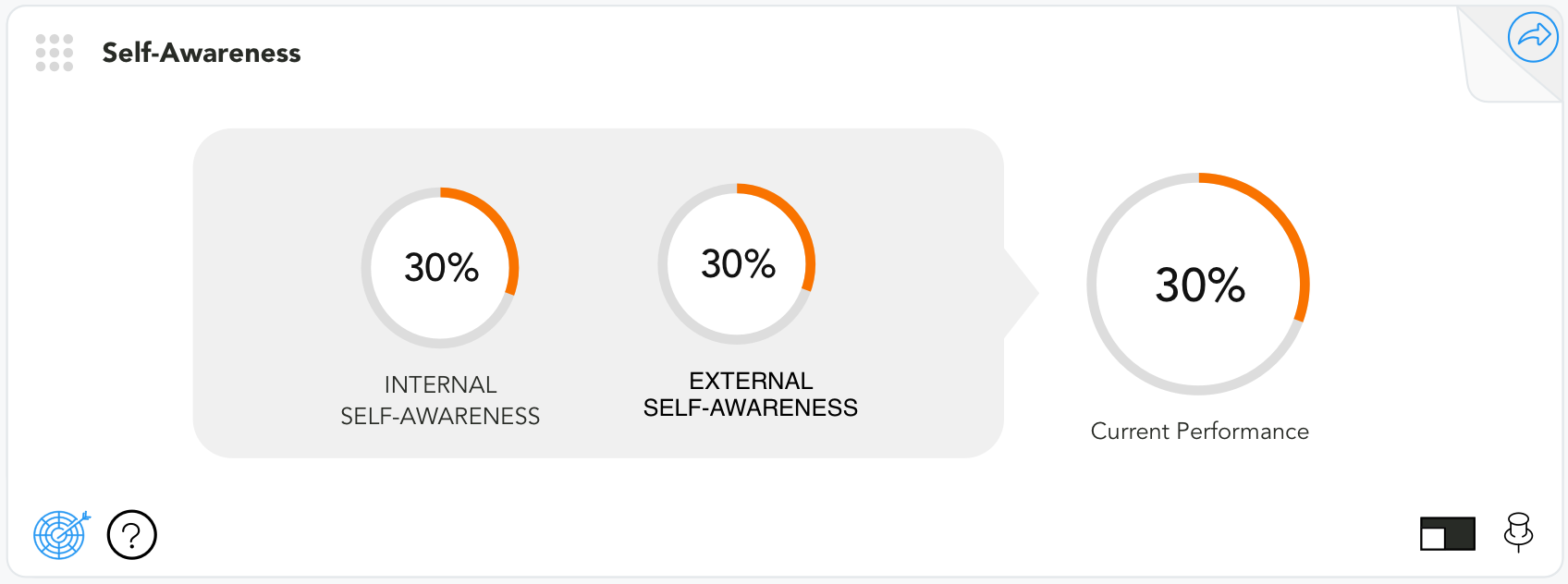
The Critical Threshold of Self-Awareness
In order to tell you more about the importance of monitoring Self-Awareness during a training program on leadership, let me introduce two different case studies in which we monitored the development of the performance in critical conversations -which we call “Confidence”- in connection with the development of Self-Awareness.
- The first case study is a project we delivered for a health system operating eight hospitals. We were asked to help design a meaningful training program for developing their managers’ conversational behaviors. The practice schedule was set in a way that, on average, each trainee was taking one simulated conversation per week, over a 20-week program. A total of around 1,500 hours of training was provided to around 200 Leaders involved in the initiative.
- The second case study is a project we developed for a bank in which the middle management was involved in a massive program of leadership development and we were in charge of the practical training on critical conversations. The project was delivered over the course of 12 months with 1200 managers involved in an average of 1 role play / week each.
In both cases, we recorded a very interesting correlation between the two variables. As you can see from the graphics below, the improvement in performance started to boost after the Self-Awareness crossed a specific level, a “threshold”.
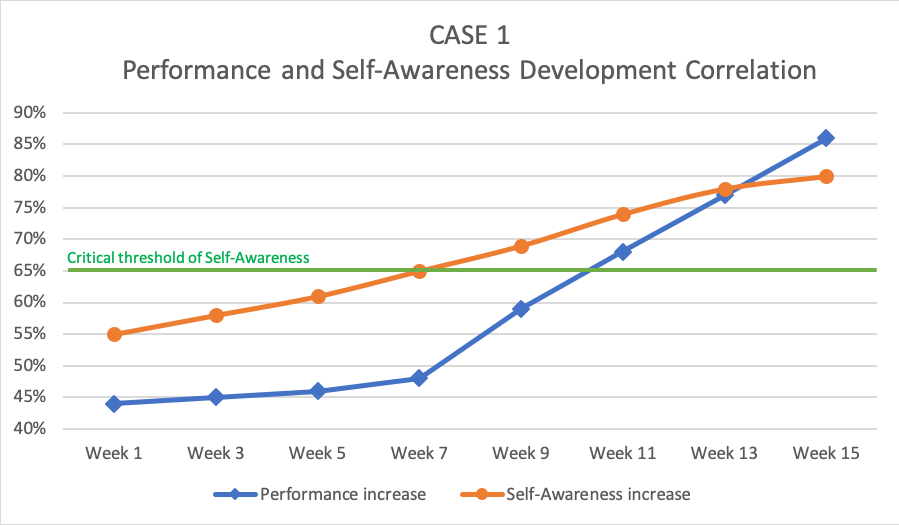
In Case Study ONE, it took around seven weeks of practicing -at a low pace- to start obtaining a significant increase in self-awareness. Until then, the overall performance in conversation management was growing at a very slow pace.
But once the trainees reached the critical threshold of 65% in self-awareness, the performance in conversations started to grow faster as well.
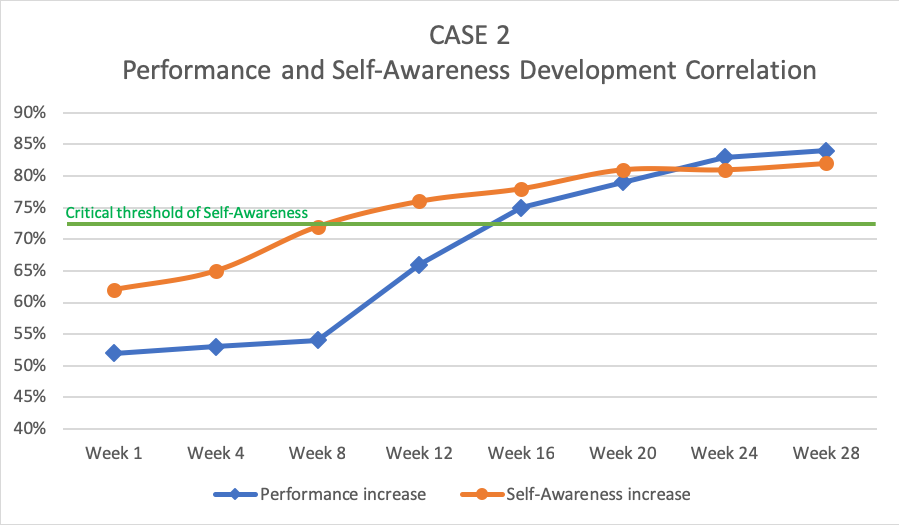
In Case Study TWO, after eight weeks of practicing Self-Awareness the threshold of 72% was crossed, at which point the performance started to grow at a higher speed as well.
We see this phenomenon happen quite frequently when analyzing our Big Data from the practical training sessions.
In fact, performance is related to Learning Agility and Learning Agility widely depends upon Self-Awareness.
Until the trainees are sufficiently aware of the impact of their own performance, it is more difficult for them to focus on changing their behaviors.
As self-awareness finally clicks thus revealing this blind spot, learners start realizing that new behaviors are necessary to achieve the results they aim for. Then they start to change for real and at a faster pace.
It is a very important point: evidence suggests that there is a threshold above which it becomes easier to turn experience into new behaviors; and new behaviors into better performance. There is no fixed measure for such threshold, of course.
It may vary according to each individual and it does not make much sense to think in terms of averages, but rather try to shape a general conceptual framework.
Defining a specific and unique percentage doesn’t matter; what we see is that most of our trainees, once achieving a certain level of Self-Awareness, improve on the other skills at a much faster pace.
The point, however, is that it is highly unlikely for trainees to start the training program at their threshold. Whatever the threshold is, the percentage of “ignition” is typically quite high.
Evidence show us a totally different scenario with regard to the level of Self-Awareness at which the average trainee enters our conversational leadership training programs. Take a look at the data below.
A look at Leaders’ average Self-Awareness
Looking at the enormous amount of data available in SkillGym -we track over six million simulated critical conversations by 250k+ Leaders around the world- it is interesting to notice the following distribution with regard to the “entrance” Self-Awareness (i.e., the level of Self-Awareness recorded at the trainees’ first assessment with a Digital Role Play).
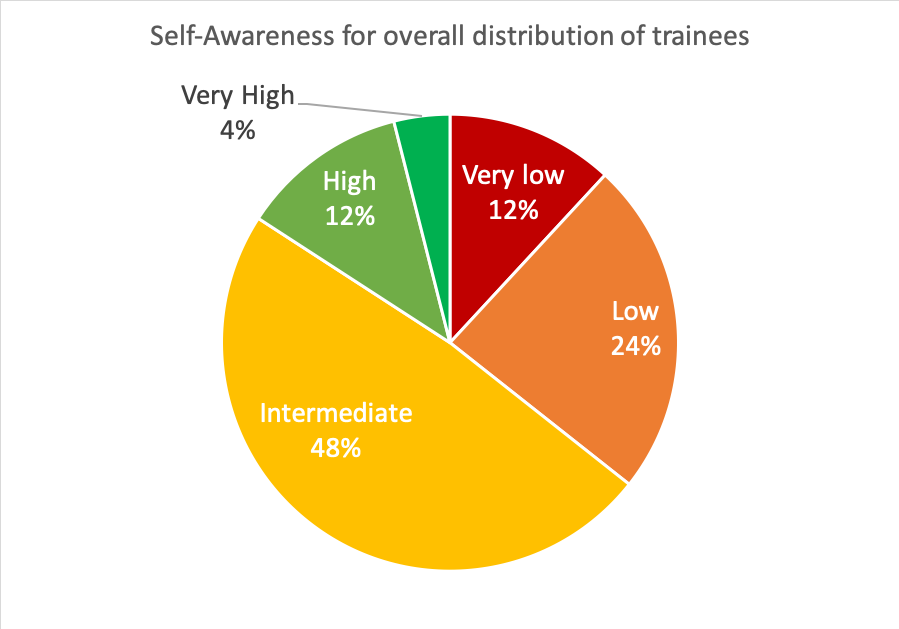
Where the five thresholds are:
| Threshold | Range of Self-Awareness | Percentage of the population |
|---|---|---|
Very Low |
Lower than 35% |
12% |
Low |
Between 35 and 50% |
24% |
Intermediate |
Between 50% and 60% |
48% |
High |
Between 60% and 80% |
12% |
Very High |
Over 80% |
4% |
Basically, our evidence shows how a large majority of Leaders appear to have an intermediate level of Self-Awareness, with a slight predominance of Internal over External Self-Awareness.
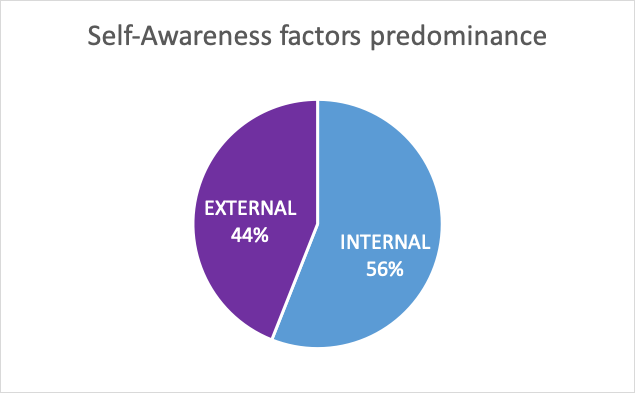
This is a very important point, since the intermediate level of Self-Awareness is far below the level of threshold discussed above. This means that a considerable part of the training effort is normally devoted to increasing Self-Awareness before being able to enjoy the benefits of faster improvement in performance.
A considerable part of the training effort is normally devoted to increasing Self-Awareness before being able to enjoy the benefits of faster improvement in performance.
Another interesting piece of evidence we collected is about the distribution of Self-Awareness according to the seniority in role (number of years):
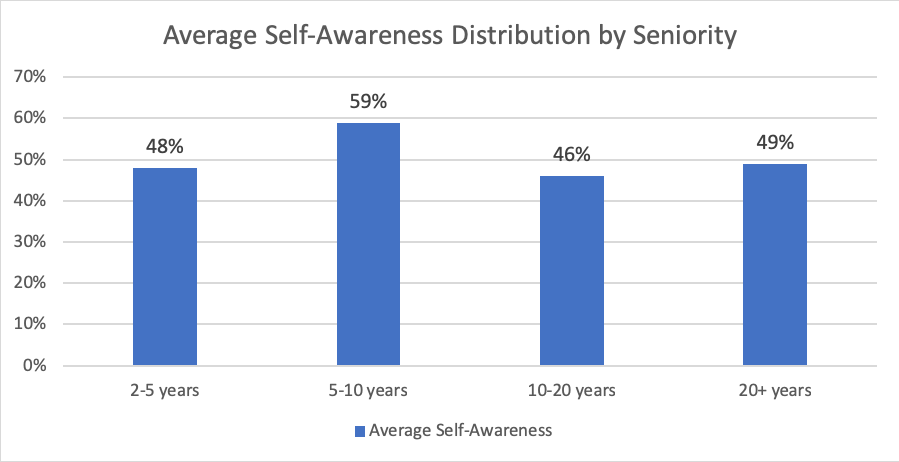
Interesting, isn’t it?
Apparently the more the seniority, the lower the Self-Awareness. It looks like that experience leads to a false sense of confidence, making Leaders overconfident about their level of expertise.
Apparently the more the seniority, the lower the Self-Awareness. It looks like that experience leads to a false sense of confidence, making Leaders overconfident about their level of expertise.
Practicing on conversations for developing Self-Awareness
Building on Self-Awareness development is a great approach to pave the way to any leadership growth. Of course, there are several ways to develop this factor, but few are as efficient and effective as practicing critical conversations.
We are totally aware, however, that practicing critical conversations through a Digital Role Play system does not provide the means for addressing allof the aspects of one’s own self-awareness.
All our triggers, in fact, are directed only to the skills underlying the conversational behaviors we address, in a context characterized by:
- Certain types of critical conversations
- One or more objectives to achieve
- One or more types of psychological profiles
- A set of behaviors, connected to one or more leadership styles that are deemed as appropriated for the specific situation, according to the several theories and models underlying our methodology
That said, we see from field evidence that training in critical conversations using our learning triggers generates a very high impact -level of improvement and efficiency- on the development of Self-Awareness.
There is a reason why training in conversational leadership with Digital Role Play can accelerate the development of crystal-clear self-awareness. Human beings fear confrontation, but when confrontation happens, it becomes a great time for inner self-discussion.
Digital Role Plays are the safest way to make this confrontation happen. And the feedback session at the end of each simulation, especially when delivered in the form of a subjective and emotional feedback of the character with whom the trainee was practicing, is a fantastic accelerator of inner self-discussion.
That’s when Self-Awareness gets sharper and sharper.
And if we consider Self-Awareness as the result of an exercise of focusing on our own limits, potential, strengths and weaknesses, certainly practicing in the above context is a great exercise to stimulate a more general approach of self-assessment and self-reflection.
Factors stimulating Self-Awareness
Our methodology of leadership development through practice on critical conversations relies on the following powerful learning triggers, capable of stimulating trainees’ Self-Awareness (more details of how a SkillGym Digital Role Play works, in this article “Digital Role Plays, the Best Way to Develop Conversational Leadership”):
- Self-evaluation questions during and at the end of the conversation, as seen above
- Emotional feedback provided by the character at the end of the simulation
- Objective metrics showing the actual synthetic outcome of the conversation
- Objective analysis of every single behavior applied and relevant impact, as outlined by our powerful Augmented Replay
For obvious reasons, we can’t measure the impact on Self-Awareness of other factors external to the simulation’s environment, such as the effects of a tutor-led session to discuss one specific conversation.
Over the years, we have carried out several experiments to assess which of the above triggers works best for the development of Self-Awareness and, not surprisingly, we found that the following two:
- Self-evaluation questions during and at the end of the conversation, as seen above
- Emotional feedback provided by the character at the end of the simulation
when compared to the other two (more rational) factors are absolutely the key triggers to stimulate the trainees’ attention to the present situation and generate a need for more focused self-evaluation.
However, when the four factors come together, it’s where the maximum elicitation of self-awareness happens. We discuss this in greater detail with regard to triggering both sides of the brain with emotional and rational feedback in this interesting article (“Why Stimulate Self-Awareness by Using Both Sides of Your Brain?”).
Finally, in this article (“10 Reasons Why You Should Consider SkillGym for Your Next Leadership Development and Maintenance Program”), I discuss ten good reasons to consider Digital Role Play as a great learning strategy for leadership development including some useful reflection on how to choose wisely the type of solution among those available on the market.
Feel free to comment below or book a 1-hour discovery call of SkillGym.

